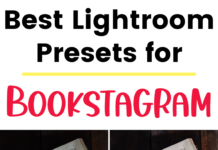If you click on the links in this post, we may earn money from the companies mentioned in this post, at no extra cost to you. You can read the full disclaimer here.
If you sell online products or goods online, then a great way to help increase your sales and profits is by using Google Shopping.
Google Shopping is available to merchants who sell products online (both tangible and downloadable products). You may have noticed Google Shopping ads when you have googled a product. You can see them at the top along with a picture, price and other details. They are a wonderful advertising opportunity for online retailers because it is a way to get your product to the top of Google. They are also, generally speaking, more cost-effective and a better way to generate sales than traditional text ads. And you can get started fairly quickly if you use a great ecommerce platform. Shopify and BigCommerce have free apps that can help you get your products on Google Shopping and there’s a great Product CSV Import Suite for WooCommerce sites that helps you save time by uploading your products into
But like all advertisement, just simply doing isn’t enough to help you increase sales; you’ll need to figure out the most effective way for you to use Google Shopping. Every business is different and what works for one retailer may not work for another, but there are some general ways that you can optimize your Google Shopping Campaigns to make them a lot more effective. This is great advice for anyone who is unhappy with their Google Shopping Campaign results or for beginners to Google Shopping. Here are 12 of our tips.
- Make sure your product titles are great. According to BigCommerce, around 80% of the reason your ads will show up on Google is because of your title – so make sure it is great! Make sure your title is accurate & descriptive so Google will know what it is. Use the name of the product and use other factors (like brand, color, size, gender, etc.) to differentiate it from other products (like “Women’s Levi’s Dark Blue High Rise Skinny Jeans” instead of “pants”). Put the information you feel is most important at the beginning of the title. What’s really great is you can get a great keyword in as long as it accurately depicts the product (like, even if you want to show up high for the phrase “inexpensive sunglasses” don’t include that if the product is, well, women’s jeans). If you need help coming up with good keywords, see our SEO tips here. Make sure, however, you are not vague, you don’t write in all caps (which is a good rule in general), you add promotional text (such as a sale – that can come later, but it is against Google’s policy to have a sale listed in the title) and it’s under 150 characters (because that’s the limit).
- Also make sure your product description is great. Per Shopify, your product description is second in importance to title. This is another chance for you to use great keywords to help you show up better when people Google for products. Similarly to your title, make sure you put your most important information first but don’t just “stuff keywords” (such as being repetitive like writing “A woman’s shirt for women that women wear”), just accurately describe the product using some great keywords. And keep it shorter than 5,000 characters, because that is Google’s character limit.
- Display star ratings below your Google Shopping ads. 91% of consumers ages 18-34 years old trust online reviews as much as personal recommendations, so seeing the star ratings can make people more likely to click on your ad and buy your product. Additionally, not every product on Google Shopping has ratings listed, so it can really make your product stand out. You can easily add this if you use WooCommerce with WooCommerce Google Product Review Feed for Google Shopping Ads.
- Make sure your use the best Google Product Category for your products. This helps Google know what your product is which helps them know to display your ad when someone searches for it.
- Similarly, make sure your Google Product Type is as accurate as possible, so Google knows when to display your ads to the right people.
- Make sure your image is very clear and attractive so that it stands out next to the competition. Consider getting a better camera to help you with this. Also make sure that your photo adheres to Google’s standards: i.e., no text, logos or watermarks and that the background of your photo is white.
- Make sure you are bidding enough so your products show up. Big Commerce recommends starting at $10/day – which is exactly what I’ve found is the best – so you don’t spend too much at the beginning but you’re spending enough so your ads do show up. If you spend too little, you can never outbid anyone and then essentially your whole campaign is pointless.
- If your product isn’t showing up enough, make sure your max CPC bid is high enough, because your products may not be showing up enough because you are just getting outbid and everything I mentioned earlier then becomes less important. Sometimes a successful Google Ad Campaign means tweaking your CPC amount.
- Within your budget panel, you can select “standard” or “accelerated”. Big Commerce suggests accelerated and I would agree with this, too – I would rather quickly run out my budget but get my ads shown that for my ads to be shown slowly and rarely.
- If you don’t feel your ad is being shown enough on Google, and your ads are only targeting the Search Network, consider targeting Google Search partners. This will help your ad get shown up in other places (like YouTube & the images tab) and these could help your ad finally get seen more if your products have a lot of competition.
- Make sure your ad campaign is only targeting the right people geographically. For example, if you only ship to the United States, then make sure you are only targeting people in the United States.
- Make sure you use multiple ad groups so that you can know which ads are doing well and which ads aren’t.






























